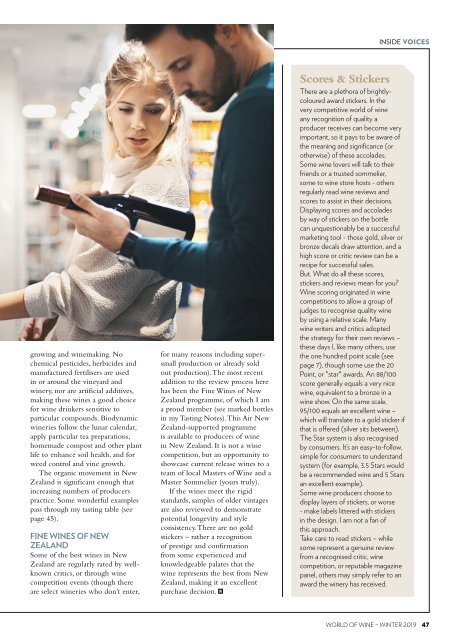You also want an ePaper? Increase the reach of your titles
YUMPU automatically turns print PDFs into web optimized ePapers that Google loves.
INSIDE VOICES<br />
growing and winemaking. No<br />
chemical pesticides, herbicides and<br />
manufactured fertilisers are used<br />
in or around the vineyard and<br />
winery, nor are artificial additives,<br />
making these wines a good choice<br />
for wine drinkers sensitive to<br />
particular compounds. Biodynamic<br />
wineries follow the lunar calendar,<br />
apply particular tea preparations,<br />
homemade compost and other plant<br />
life to enhance soil health, and for<br />
weed control and vine growth.<br />
The organic movement in New<br />
Zealand is significant enough that<br />
increasing numbers of producers<br />
practice. Some wonderful examples<br />
pass through my tasting table (see<br />
page 45).<br />
FINE WINES OF NEW<br />
ZEALAND<br />
Some of the best wines in New<br />
Zealand are regularly rated by wellknown<br />
critics, or through wine<br />
competition events (though there<br />
are select wineries who don’t enter,<br />
for many reasons including supersmall<br />
production or already sold<br />
out production). The most recent<br />
addition to the review process here<br />
has been the Fine <strong>Wine</strong>s of New<br />
Zealand programme, of which I am<br />
a proud member (see marked bottles<br />
in my Tasting Notes). This Air New<br />
Zealand-supported programme<br />
is available to producers of wine<br />
in New Zealand. It is not a wine<br />
competition, but an opportunity to<br />
showcase current release wines to a<br />
team of local Masters of <strong>Wine</strong> and a<br />
Master Sommelier (yours truly).<br />
If the wines meet the rigid<br />
standards, samples of older vintages<br />
are also reviewed to demonstrate<br />
potential longevity and style<br />
consistency. There are no gold<br />
stickers – rather a recognition<br />
of prestige and confirmation<br />
from some experienced and<br />
knowledgeable palates that the<br />
wine represents the best from New<br />
Zealand, making it an excellent<br />
purchase decision. W<br />
Scores & Stickers<br />
There are a plethora of brightlycoloured<br />
award stickers. In the<br />
very competitive world of wine<br />
any recognition of quality a<br />
producer receives can become very<br />
important, so it pays to be aware of<br />
the meaning and significance (or<br />
otherwise) of these accolades.<br />
Some wine lovers will talk to their<br />
friends or a trusted sommelier,<br />
some to wine store hosts - others<br />
regularly read wine reviews and<br />
scores to assist in their decisions.<br />
Displaying scores and accolades<br />
by way of stickers on the bottle<br />
can unquestionably be a successful<br />
marketing tool - those gold, silver or<br />
bronze decals draw attention, and a<br />
high score or critic review can be a<br />
recipe for successful sales.<br />
But. What do all these scores,<br />
stickers and reviews mean for you?<br />
<strong>Wine</strong> scoring originated in wine<br />
competitions to allow a group of<br />
judges to recognise quality wine<br />
by using a relative scale. Many<br />
wine writers and critics adopted<br />
the strategy for their own reviews –<br />
these days I, like many others, use<br />
the one hundred point scale (see<br />
page 7), though some use the 20<br />
Point, or *star* awards. An 88/100<br />
score generally equals a very nice<br />
wine, equivalent to a bronze in a<br />
wine show. On the same scale,<br />
95/100 equals an excellent wine –<br />
which will translate to a gold sticker if<br />
that is offered (silver sits between).<br />
The Star system is also recognised<br />
by consumers. It’s an easy-to-follow,<br />
simple for consumers to understand<br />
system (for example, 3.5 Stars would<br />
be a recommended wine and 5 Stars<br />
an excellent example).<br />
Some wine producers choose to<br />
display layers of stickers, or worse<br />
- make labels littered with stickers<br />
in the design. I am not a fan of<br />
this approach.<br />
Take care to read stickers – while<br />
some represent a genuine review<br />
from a recognised critic, wine<br />
competition, or reputable magazine<br />
panel, others may simply refer to an<br />
award the winery has received.<br />
WORLD OF WINE – WINTER <strong>2019</strong> 47

















